Note
Access to this page requires authorization. You can try signing in or changing directories.
Access to this page requires authorization. You can try changing directories.
In this quickstart, you use a direct method to control a simulated device connected to Azure IoT Hub. IoT Hub is an Azure service that enables you to manage your IoT devices from the cloud and ingest high volumes of device telemetry to the cloud for storage or processing. You can use direct methods to remotely change the behavior of a device connected to your IoT hub. This quickstart uses two applications: a simulated device application that responds to direct methods called from a back-end service application and a service application that calls the direct method on the Android device.
Prerequisites
An Azure account with an active subscription. Create trial.
Android Studio with Android SDK 27. For more information, see Install Android Studio.
Git.
Device SDK sample Android application, included in the Azure IoT SDKs for Java repository.
Service SDK sample Android application, included in the Azure IoT SDKs for Java repository.
Port 8883 open in your firewall. The device sample in this quickstart uses MQTT protocol, which communicates over port 8883. This port may be blocked in some corporate and educational network environments. For more information and ways to work around this issue, see Connecting to IoT Hub (MQTT).
You can use the local Azure CLI.
If you prefer, install the Azure CLI to run CLI reference commands.
Local Azure CLI, see how to install the Azure CLI. If you're running on Windows or macOS, consider running Azure CLI in a Docker container. For more information, see How to run the Azure CLI in a Docker container.
Sign in to the Azure CLI by using the az login command. To finish the authentication process, follow the steps displayed in your terminal. For other sign-in options, see Sign in with the Azure CLI.
When you're prompted, install the Azure CLI extension on first use. For more information about extensions, see Use extensions with the Azure CLI.
Run az version to find the version and dependent libraries that are installed. To upgrade to the latest version, run az upgrade.
Note
This article uses the newest version of the Azure IoT extension, called azure-iot. The legacy version is called azure-cli-iot-ext. You should only have one version installed at a time. You can use the command az extension list to validate the currently installed extensions.
Use az extension remove --name azure-cli-iot-ext to remove the legacy version of the extension.
Use az extension add --name azure-iot to add the new version of the extension.
To see what extensions are currently installed, use az extension list.
Create an IoT hub
If you completed the previous Quickstart: Send telemetry from a device to an IoT hub, you can skip this step and use the IoT hub you have already created.
This section describes how to create an IoT hub using the Azure portal.
Sign in to the Azure portal.
On the Azure homepage, select the + Create a resource button.
From the Categories menu, select Internet of Things, and then select IoT Hub.
On the Basics tab, complete the fields as follows:
Important
Because the IoT hub will be publicly discoverable as a DNS endpoint, be sure to avoid entering any sensitive or personally identifiable information when you name it.
Property Value Subscription Select the subscription to use for your hub. Resource group Select a resource group or create a new one. To create a new one, select Create new and fill in the name you want to use. IoT hub name Enter a name for your hub. This name must be globally unique, with a length between 3 and 50 alphanumeric characters. The name can also include the dash ( '-') character.Region Select the region, closest to you, where you want your hub to be located. Some features, such as IoT Hub device streams, are only available in specific regions. For these limited features, you must select one of the supported regions. Tier Select the tier that you want to use for your hub. Tier selection depends on how many features you want and how many messages you send through your solution per day.
The free tier is intended for testing and evaluation. The free tier allows 500 devices to be connected to the hub and up to 8,000 messages per day. Each Azure subscription can create one IoT hub in the free tier.
To compare the features available to each tier, select Compare tiers. For more information, see Choose the right IoT Hub tier and size for your solution.Daily message limit Select the maximum daily quota of messages for your hub. The available options depend on the tier you select for your hub. To see the available messaging and pricing options, select See all options and select the option that best matches the needs of your hub. For more information, see IoT Hub quotas and throttling. 
Note
Prices shown are for example purposes only.
Select Next: Networking to continue creating your hub.
On the Networking tab, complete the fields as follows:
Property Value Connectivity configuration Choose the endpoints that devices can use to connect to your IoT hub. Accept the default setting, Public access, for this example. You can change this setting after the IoT hub is created. For more information, see IoT Hub endpoints. Minimum TLS Version Select the minimum TLS version supported by your IoT hub. Once the IoT hub is created, this value can't be changed. Accept the default setting, 1.0, for this example. 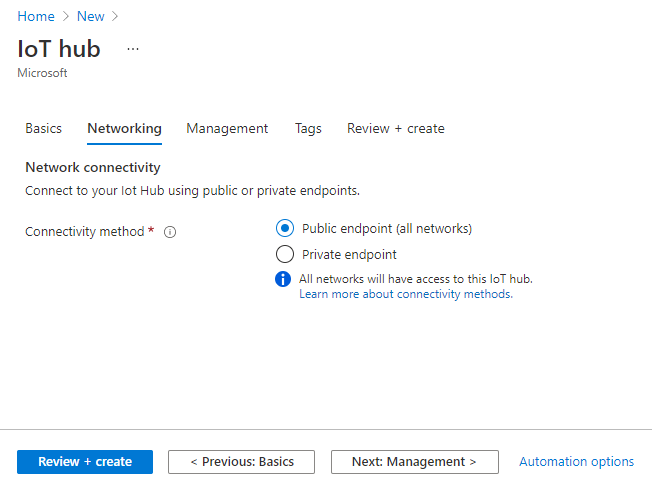
Select Next: Management to continue creating your hub.
On the Management tab, accept the default settings. If desired, you can modify any of the following fields:
Property Value Permission model Part of role-based access control, this property decides how you manage access to your IoT hub. Allow shared access policies or choose only role-based access control. For more information, see Control access to IoT Hub by using Microsoft Entra ID. Assign me You might need access to IoT Hub data APIs to manage elements within an instance. If you have access to role assignments, select IoT Hub Data Contributor role to grant yourself full access to the data APIs.
To assign Azure roles, you must haveMicrosoft.Authorization/roleAssignments/writepermissions, such as User Access Administrator or Owner.Device-to-cloud partitions This property relates the device-to-cloud messages to the number of simultaneous readers of the messages. Most IoT hubs need only four partitions. 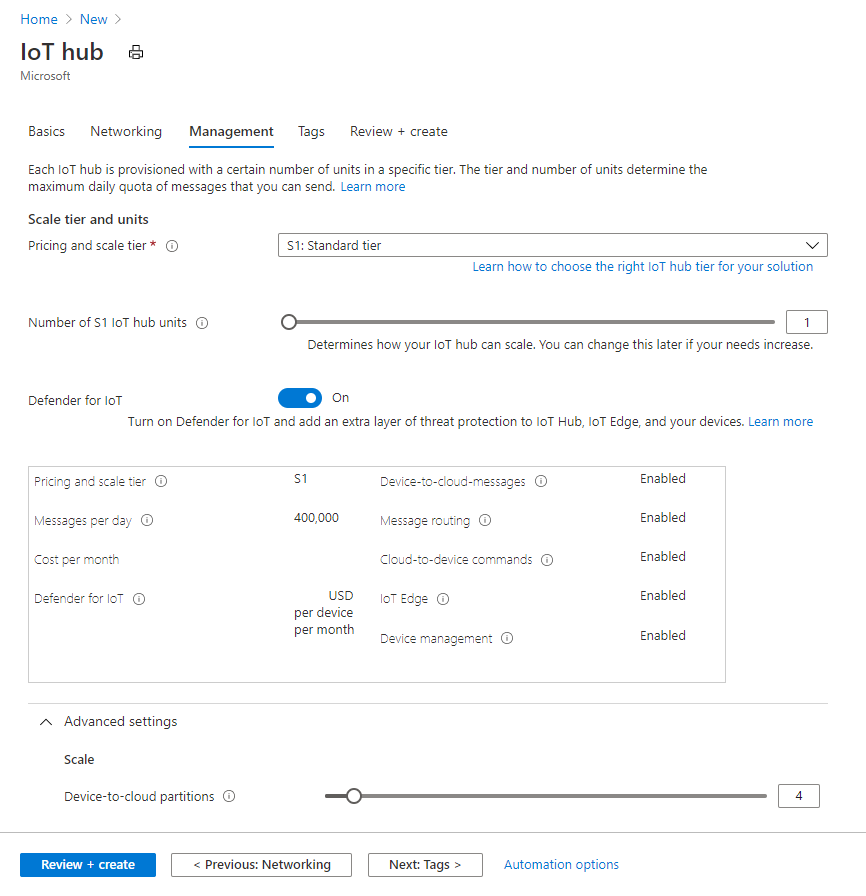
Select Next: Add-ons to continue to the next screen.
On the Add-ons tab, accept the default settings. If desired, you can modify any of the following fields:
Property Value Enable Device Update for IoT Hub Turn on Device Update for IoT Hub to enable over-the-air updates for your devices. If you select this option, you're prompted to provide information to provision a Device Update for IoT Hub account and instance. For more information, see What is Device Update for IoT Hub? Enable Defender for IoT Turn Defender for IoT on to add an extra layer of protection to IoT and your devices. This option isn't available for hubs in the free tier. For more information, see Security recommendations for IoT Hub in Microsoft Defender for IoT documentation. 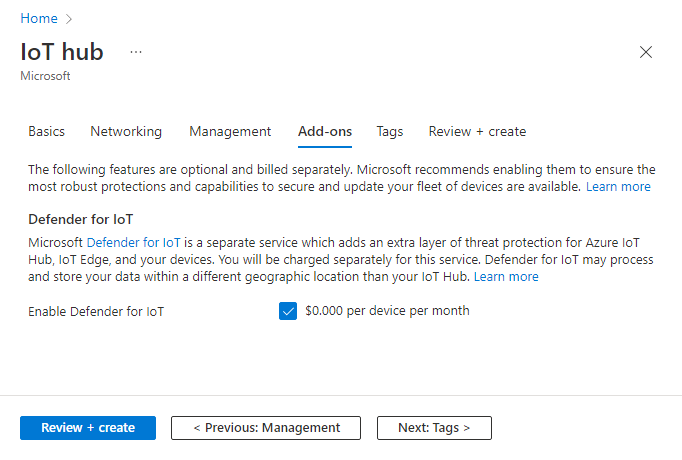
Note
Prices shown are for example purposes only.
Select Next: Tags to continue to the next screen.
Tags are name/value pairs. You can assign the same tag to multiple resources and resource groups to categorize resources and consolidate billing. In this document, you don't add any tags. For more information, see Use tags to organize your Azure resources and management hierarchy.

Select Next: Review + create to review your choices.
Select Create to start the deployment of your new hub. Your deployment might progress for a few minutes while the hub is being created. Once the deployment is complete, select Go to resource to open the new hub.
Register a device
If you completed the previous Quickstart: Send telemetry from a device to an IoT hub, you can skip this step and use the same device registered in the previous quickstart.
A device must be registered with your IoT hub before it can connect. In this quickstart, you use the CLI to register a simulated device.
Run the following command in terminal to create the device identity.
YourIoTHubName: Replace this placeholder below with the name you chose for your IoT hub.
MyAndroidDevice: This is the name of the device you're registering. It's recommended to use MyAndroidDevice as shown. If you choose a different name for your device, you also need to use that name throughout this article, and update the device name in the sample applications before you run them.
az iot hub device-identity create \ --hub-name {YourIoTHubName} --device-id MyAndroidDeviceRun the following commands to get the device connection string for the device you just registered:
YourIoTHubName: Replace this placeholder below with the name you choose for your IoT hub.
az iot hub device-identity connection-string show\ --hub-name {YourIoTHubName} \ --device-id MyAndroidDevice \ --output tableMake a note of the device connection string, which looks like:
HostName={YourIoTHubName}.azure-devices.cn;DeviceId=MyAndroidDevice;SharedAccessKey={YourSharedAccessKey}You use this value later in the quickstart.
Retrieve the service connection string
You also need a service connection string to enable the back-end service applications to connect to your IoT hub in order to execute methods and retrieve messages. The following command retrieves the service connection string for your IoT hub:
YourIoTHubName: Replace this placeholder below with the name you chose for your IoT hub.
az iot hub connection-string show --policy-name service --hub-name {YourIoTHubName} --output table
Make a note of the service connection string, which looks like:
HostName={YourIoTHubName}.azure-devices.cn;SharedAccessKeyName=service;SharedAccessKey={YourSharedAccessKey}
You use this value later in the quickstart. This service connection string is different from the device connection string you noted in the previous step.
Listen for direct method calls
Both of the samples for this quickstart are part of the Azure IoT SDKs for Java repository on GitHub. Download or clone the repository.
The device SDK sample application can be run on a physical Android device or an Android emulator. The sample connects to a device-specific endpoint on your IoT hub, sends simulated telemetry, and listens for direct method calls from your hub. In this quickstart, the direct method call from the hub tells the device to change the interval at which it sends telemetry. The simulated device sends an acknowledgement back to your hub after it executes the direct method.
Open the GitHub sample Android project in Android Studio. The project is located in the following directory of your cloned or downloaded copy of the Azure IoT SDKs for Java repository: \azure-iot-sdk-java\device\iot-device-samples\android-sample.
In Android Studio, open gradle.properties for the sample project and replace the Device_Connection_String placeholder with the device connection string you made a note of earlier.
DeviceConnectionString=HostName={YourIoTHubName}.azure-devices.cn;DeviceId=MyAndroidDevice;SharedAccessKey={YourSharedAccessKey}In Android Studio, click File > Sync Project with Gradle Files. Verify the build completes.
Note
If the project sync fails, it may be for one of the following reasons:
- The versions of the Android Gradle plugin and Gradle referenced in the project are out of date for your version of Android Studio. Follow these instructions to reference and install the correct versions of the plugin and Gradle for your installation.
- The license agreement for the Android SDK has not been signed. Follow the instructions in the Build output to sign the license agreement and download the SDK.
Once the build has completed, click Run > Run 'app'. Configure the app to run on a physical Android device or an Android emulator. For more information on running an Android app on a physical device or emulator, see Run your app.
Once the app loads, click the Start button to start sending telemetry to your IoT Hub:
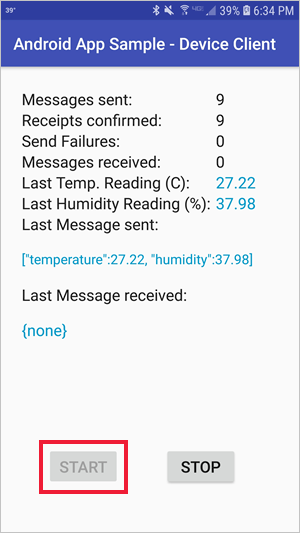
This app needs to be left running on a physical device or emulator while you execute the service SDK sample to update the telemetry interval during run-time.
Read the telemetry from your hub
In this section, you will use the Azure PowerShell with the IoT extension to monitor the messages that are sent by the Android device.
Using the Azure PowerShell, run the following command to connect and read messages from your IoT hub:
YourIoTHubName: Replace this placeholder below with the name you choose for your IoT hub.
az iot hub monitor-events --hub-name {YourIoTHubName} --output tableThe following screenshot shows the output as the IoT hub receives telemetry sent by the Android device:

By default, the telemetry app sends telemetry from the Android device every five seconds. In the next section, you will use a direct method call to update the telemetry interval for the Android IoT device.
Call the direct method
The service application connects to a service-side endpoint on your IoT Hub. The application makes direct method calls to a device through your IoT hub and listens for acknowledgements.
Run this app on a separate physical Android device or Android emulator.
An IoT Hub back-end service application typically runs in the cloud, where it's easier to mitigate the risks associated with the sensitive connection string that controls all devices on an IoT Hub. In this example, we are running it as an Android app for demonstration purposes only. The other-language versions of this quickstart provide examples that align more closely with a typical back-end service application.
Open the GitHub service sample Android project in Android Studio. The project is located in the following directory of your cloned or downloaded copy of the Azure IoT SDKs for Java repository: \azure-iot-sdk-java\device\iot-device-samples\android-sample.
In Android Studio, open gradle.properties for the sample project. Update the values for the ConnectionString and DeviceId properties with the service connection string you noted earlier and the Android device ID you registered.
ConnectionString=HostName={YourIoTHubName}.azure-devices.cn;SharedAccessKeyName=service;SharedAccessKey={YourSharedAccessKey} DeviceId=MyAndroidDeviceIn Android Studio, click File > Sync Project with Gradle Files. Verify the build completes.
Note
If the project sync fails, it may be for one of the following reasons:
- The versions of the Android Gradle plugin and Gradle referenced in the project are out of date for your version of Android Studio. Follow these instructions to reference and install the correct versions of the plugin and Gradle for your installation.
- The license agreement for the Android SDK has not been signed. Follow the instructions in the Build output to sign the license agreement and download the SDK.
Once the build has completed, click Run > Run 'app'. Configure the app to run on a separate physical Android device or an Android emulator. For more information on running an Android app on a physical device or emulator, see Run your app.
Once the app loads, update the Set Messaging Interval value to 1000 and click Invoke.
Th telemetry messaging interval is in milliseconds. The default telemetry interval of the device sample is set for 5 seconds. This change will update the Android IoT device so that telemetry is sent every second.
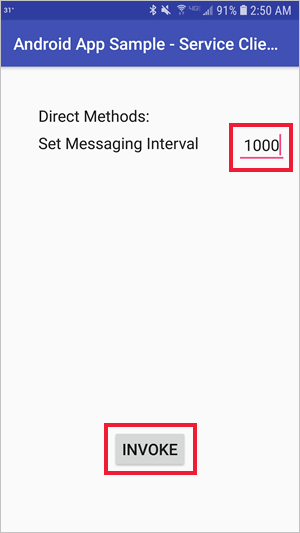
The app will receive an acknowledgment indicating whether the method executed successfully or not.
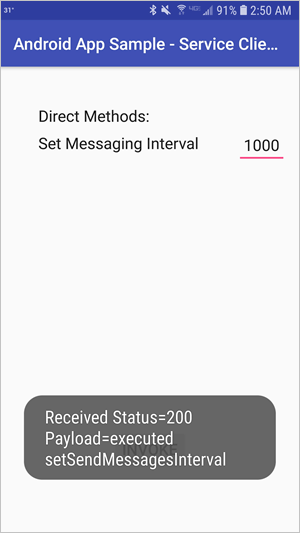
Clean up resources
If you're continuing to the next recommended article, you can keep the resources you already created and reuse them.
Otherwise, you can delete the Azure resources created in this article to avoid charges.
Important
Deleting a resource group is irreversible. The resource group and all the resources contained in it are permanently deleted. Make sure that you don't accidentally delete the wrong resource group or resources. If you created the IoT hub inside an existing resource group that contains resources you want to keep, only delete the IoT Hub resource itself instead of deleting the resource group.
To delete a resource group by name:
Sign in to the Azure portal and select Resource groups.
In the Filter for any field textbox, type the name of the resource group containing your IoT hub.
In the result list, select the resource group containing your IoT hub.
In the working pane for the resource group, select Delete resource group from the command bar.
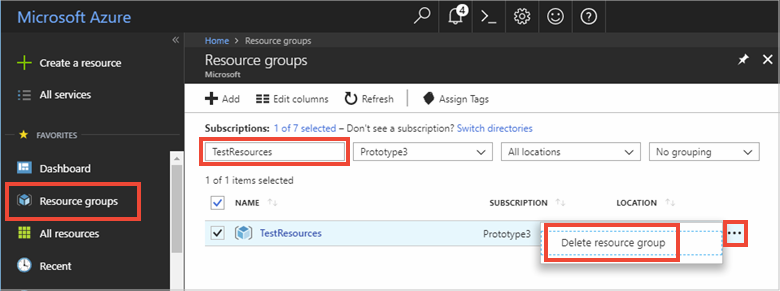
You're asked to confirm the deletion of the resource group. Type the name of your resource group again to confirm, and then select Delete. After a few moments, the resource group and all of its contained resources are deleted.
Next steps
In this quickstart, you called a direct method on a device from a back-end application, and responded to the direct method call in a simulated device application.
To learn how to route device-to-cloud messages to different destinations in the cloud, continue to the next tutorial.